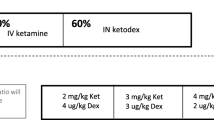Abstract
This double-blind, randomized, prospective study was conducted to compare the analgesic and sedative efficacy of fentanyl and meperidine in orthopedic closed reduction of fractures and dislocations undertaken in the emergency department. Seventy consecutive adult patients with fractures or dislocations suitable for reduction were randomized to receive fentanyl (1 mcg/kg; n=36) or meperidine (0.5 mg/kg; n=34) in combination with midazolam (0.02 mg/kg). Vital signs and alertness scale scores of the patients were monitored. The Visual Analog Scale (VAS) was used to determine the degree of pain. There was no statistically significant difference between the VAS mean scores of the fentanyl and meperidine groups (t test,P=.772). The need for additional analgesic drugs was significantly more frequent in patients receiving meperidine (P=.018). No adverse events, such as hypotension or respiratory depression, were noted. Euphoria occurred in one patient in the fentanyl group. Although dose requirements differ, fentanyl and meperidine provide effective and reliable analgesia in closed reduction of fractures and dislocations.
Similar content being viewed by others
References
Chudnofsky CR, Lozon MM. Sedation and analgesia for procedures. In: Rosen P, Barkin R, Danzl DF, Marie M.Emergency Medicine: Concepts and Clinical Practice. 4th ed. St. Louis, Mo: Mosby;1998:301–313.
Michael F, Murphy MSD. Sedation.Ann Emerg Med. 1996;27:461–463.
Nicolaou DD. Systemic analgesia and sedation for procedures. In: Tintinalli JE, Kellen GD, Stapczynski JS.Emergency Medicine. 5th ed. New York, NY: McGraw-Hill; 2000:269–274.
Melzack R, Katz J. Pain measurement in persons in pain. In: Wall PD, Melzack R, eds.Textbook of Pain. 3th ed. New York, NY: Churchill Livingstone; 1994:337–351.
Wright SW, Chudnofsky CR, Dronen SC, et al. Comparison of midazolam and diazepam for conscious sedation in the emergency department.Ann Emerg Med. 1993;22:201–208.
Friedland LR, Kulick RM. Emergency department analgesic use in pediatric trauma victims with fractures.Ann Emerg Med. 1994;23:203–207.
Singer AJ, Richman PB, Kowalska A, Thode HC. Comparison of patient and practitioner assessments of pain from commonly performed emergency department procedures.Ann Emerg Med. 1999;33:652–658.
Burton JH, Bock AJ, Strout TD, Marcolini EG. Etomidate and midazolam for reduction of anterior shoulder dislocation: a randomized, controlled trial.Ann Emerg Med. 2002;40:496–504.
Chudnofsky CR, Weber JE, Stoyanoff PJ, et al. A combination of midazolam and ketamine for procedural sedation and analgesia in adult emergency department patients.Acad Emerg Med. 2000;7:228–235.
Grant A, Hoddinott C, Evans R. Midazolam sedation for the reduction of Colles’ fractures.Injury. 1993;24:461–463.
Lerman B, Yoshida D, Levitt MA. A prospective evaluation of the safety and efficacy of methohexital in the emergency department.Am J Emerg Med. 1996;14:440.
Shane SA, Susan M, Fuchs MD, Khine H. Efficacy of rectal midazolam for the sedation of preschool children undergoing laceration repair.Ann Emerg Med. 1994;24:1065–1073.
Furia JP, Alioto RJ, Marquardt JD. The efficacy and safety of the hematoma block for fracture reduction in closed, isolated fractures.Orthopedics. 1997;20:423–426.
Terndrup TE, Dire DJ, Madden CM, et al. Comparison of intramuscular meperidine and promethazine with and without chlorpromazine.Ann Emerg Med. 1993;22:206–211.
Billmire DA, Neale HW, Gregory RO. Use of IV fentanyl in the outpatient treatment of pediatric facial trauma.J Trauma. 1985;25:1079–1080.
Schutzman SA, Burg J, Liebelt E, et al. Oral transmucosal fentanyl citrate for premedication of children undergoing laceration repair.Ann Emerg Med. 1994;24:1059–1064.
Theroux MC, West DW, Corddry DH, et al. Efficacy of intranasal midazolam in facilitating suturing of lacerations in preschool children in the emergency department.Pediatrics. 1993; 91:624–627.
Kanegaye JT, Favela JL, Acosta M, Bank DE. High-dose rectal midazolam for pediatric procedures: a randomized trial of sedative efficacy and agitation.Pediatr Emerg Care. 2003;19:329–336.
Jantos TJ, Paris PM, Menegazzi JJ, Yealy DM. Analgesic practice for acute orthopedic trauma pain in Costa Rican emergency departments.Ann Emerg Med. 1996;28:145–150.
Author information
Authors and Affiliations
Rights and permissions
About this article
Cite this article
Soysal, S., Karcioglu, O., Demircan, A. et al. Comparison of meperidine plus midazolam and fentanyl plus midazolam in procedural sedation: A double-blind, randomized controlled trial. Adv Therapy 21, 312–321 (2004). https://doi.org/10.1007/BF02850035
Issue Date:
DOI: https://doi.org/10.1007/BF02850035




